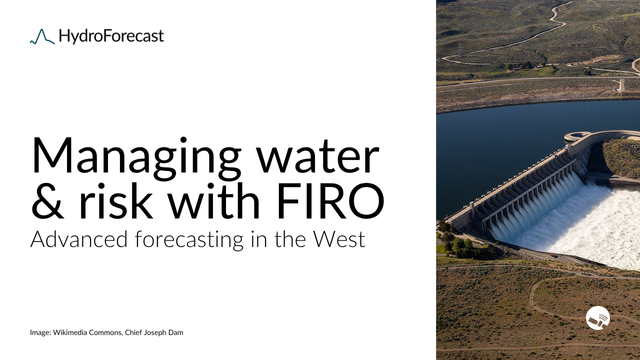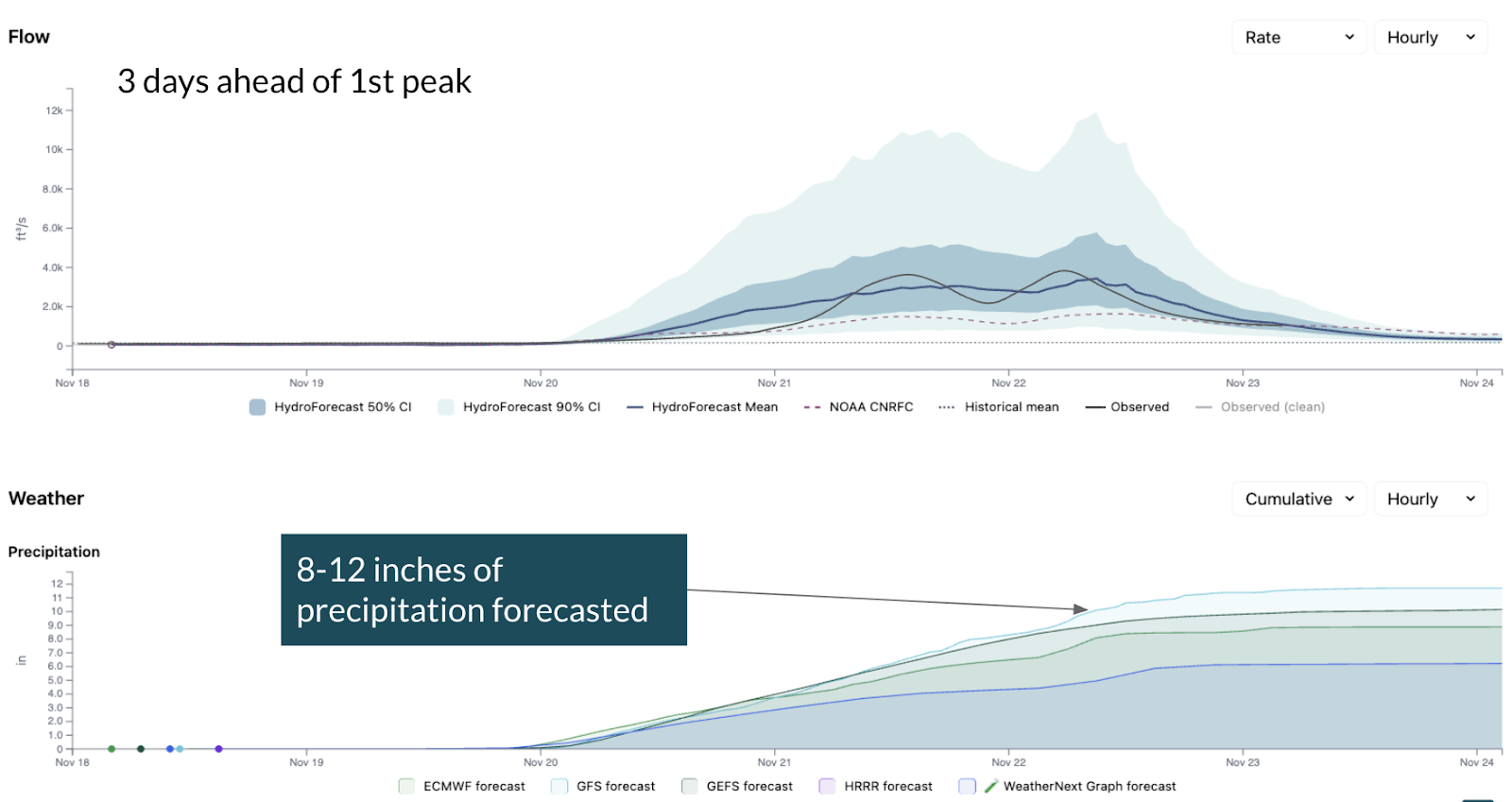
For water managers, risk management is at the heart of everything they do. Especially in the Western United States, the annual cycle of snowpack and dry summers may seem like predictable patterns, but the specifics of when, where, and how much precipitation will fall remain uncertain.
Water managers are then faced with critical trade-offs: how to manage flood risk today without jeopardizing water supply for tomorrow.
Today, advanced forecasts are transforming operations, particularly through programs like Forecast-Informed Reservoir Operations (FIRO) that help integrate forecast data faster and more effectively into decision-making.
Since the mid-1940s, the U.S. Army Corps of Engineers (USACE) has managed flood control at federally funded dams using Water Control Manuals (WCMs), which represent decades of trusted, state-of-the-art reservoir management practices. Central to these manuals are “guide curves”—seasonal storage limits based on historical flood risks and past climate patterns. Once a conservative safeguard in the absence of advanced forecasting, these static rules now face growing limitations as climate change disrupts historical norms. Weather patterns are shifting, and relying on past data alone introduces new risks.
In Butte County, California, for example, rising winter temperatures over the past three decades have increased the likelihood of rain-on-snow events. These events heighten risk by introducing greater uncertainty into runoff patterns, especially when they are induced by large, concentrated storms like atmospheric rivers, which are responsible for 30-50% of the annual precipitation in parts of the Western U.S. Rain-on-snow events triggered by atmospheric rivers can induce sudden, extreme inflows, compounding flood risk and placing significant strain on dam infrastructure. The 2017 Oroville Dam crisis was one such case, when a rain-on-snow event driven by an atmospheric river caused dangerous inflows that overwhelmed spillway capacity.

As warmer winter months become more common across the West, the potential for large, rapid melt events will continue to grow—elevating risks to lives, ecosystems, and downstream assets. Strict guide curves, rooted in historical data, were never designed to anticipate these complex, fast-changing conditions. Addressing this challenge calls for a new paradigm: flexible, forecast-informed operations that adapt in real time rather than rely solely on static rules.
FIRO is a modern management framework that integrates advanced weather and streamflow forecasts into reservoir operations. Instead of rigid rules, operators use the best available data to decide when to release or retain water—balancing flood protection during storms with water supply reliability in dry periods. Institutions like NOAA and the Center for Western Weather and Water Extremes (CW3E) have been central to advancing our understanding of extreme precipitation events, laying the scientific foundation for FIRO.
FIRO gained momentum after 2013, when precautionary flood-control releases from Lake Mendocino during major atmospheric river storms were followed by a prolonged drought that strained Sonoma Water’s supply. The incident sparked a fundamental question: If reliable forecasts exist, why base decisions solely on current and historical observations?
FIRO emerged in response—providing flexibility and enabling agencies like the USACE to integrate a range of forecast tools, adapt strategies to local needs, and act proactively rather than reactively. In essence, the framework provides the operational space for innovation, empowering managers to respond more effectively in a changing world.

The value of FIRO depends heavily on the quality of the forecasts it incorporates. Not all forecasts are created equal—differences in spatial resolution, lead time, update frequency, and accuracy can significantly impact outcomes. To get the most out of the FIRO approach, it’s critical to integrate high-quality, probabilistic streamflow forecasts, alongside meteorological forecasts, that offer both reliability and useful uncertainty estimates. Such forecasts allow managers to anticipate not just precipitation volume, but also how water will move through the catchment.
These insights are critical to making smarter trade-offs: reducing flood risk without compromising water supply, and responding to rapidly changing conditions with confidence. As we saw at Lake Mendocino in 2013 and Lake Oroville in 2017, the systems in place to manage these pieces of critical infrastructure were not necessarily built to adapt to a changing climate. The FIRO framework allows for the possibility of adaptation, and with it safer asset management, but the framework is only as strong as the forecasts that support it—choosing the right ones makes all the difference.
Delivering AI-driven probabilistic streamflow predictions, HydroForecast complements the meteorologic and atmospheric forecasts that currently support the FIRO framework. The AI-powered model infrastructure of HydroForecast enhances physics-based, deterministic hydrologic forecasts with:
HydroForecast fits naturally within the FIRO framework. It doesn’t replace the foundational forecasts from NOAA or CW3E—instead, it supplements these forecasts, and even has the ability to integrate them, translating meteorologic forecasts to probabilistic reservoir inflows.

A key principle of FIRO is that operators remain in control—the framework doesn't automate decision-making. By layering in HydroForecast, reservoir managers expand their decision space, gaining deeper insight into potential inflows, uncertainty bands, and evolving conditions. Just as water managers blend data, past experience, and policy constraints to the decision making process, so too should they consider high-resolution, probabilistic streamflow forecasts to inform their operational decisions. It’s about managing risk with more informed decision making, not more rigidity.
By integrating FIRO with HydroForecast’s improved forecasts, operators can:
The adoption of forecast informed reservoir operations is a transformational step for responsible water management in an era of more accurate forecasting. If these frameworks are not developed in a way that allows for continuous improvement, however, they run the same risk that we have seen with WCM guide curves in the past - a data limited, ultra conservative approach to water management as we saw with Lake Mendocino in 2013. In an era of extended drought coupled with growing population centers throughout the west, the risk of water stress is one that is critical to balance alongside flood risk.
The adoption of HydroForecast by key federal agencies and reservoir operators speaks to the value it provides in these decision making frameworks. In 2025, Reclamation initiated the integration of HydroForecast at multiple reservoirs, recognizing the value of probabilistic inflow forecasts to quantify uncertainty during critical inflow events. Sonoma Water has been using HydroForecast to inform their operational decisions since 2022.
While not yet part of the USACE FIRO program, we advocate that HydroForecast is a powerful accompaniment, with forecasts that move the needle for operational users who are seeking more accuracy and better risk-based tools.

As USACE evaluates new locations for suitability within their FIRO program, we advocate that HydroForecast be a standard piece of this viability assessment process. Under the current process, outlined in the above figure, “if the viability assessment demonstrates that FIRO results in better outcomes compared to existing operations, then implementation of FIRO is pursued via a WCM update”. We believe that the integration of HydroForecast into the USACE FIRO tool kit will increase the likelihood of a successful FIRO implementation, just as it has for organizations like Reclamation and Sonoma Water.
Risk management plays a role in every decision made by reservoir operators. There is risk in the integration of new tools, of course, but there is also risk in limiting the decision space. The FIRO framework is meant to allow for more flexible reservoir operations in the face of deviations from historical weather patterns coupled with advanced forecasting ability. In a time when forecasting capabilities and technology advancements are extremely fast moving, it is critical that this framework maintains adaptability to new technologies that support the mission of more informed water management decisions.
To learn more about HydroForecast supports water management, contact our team.